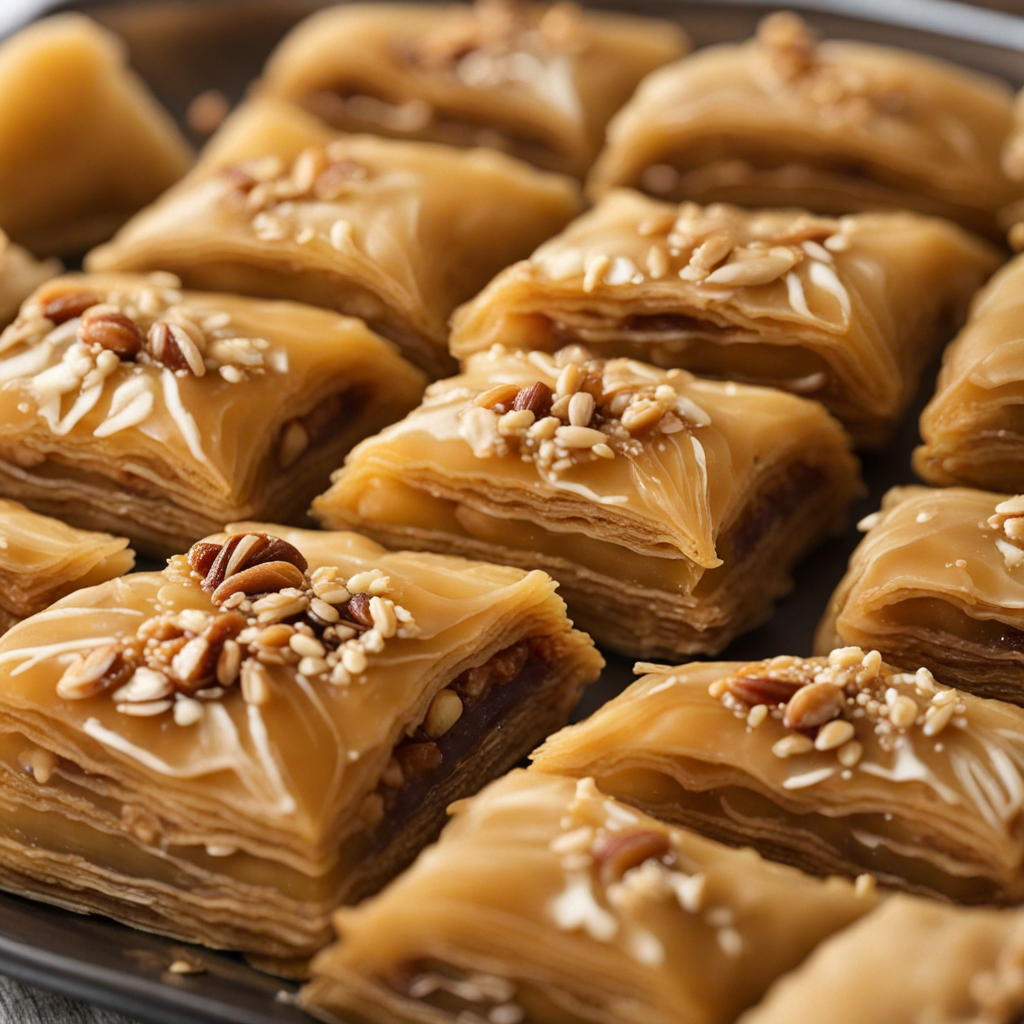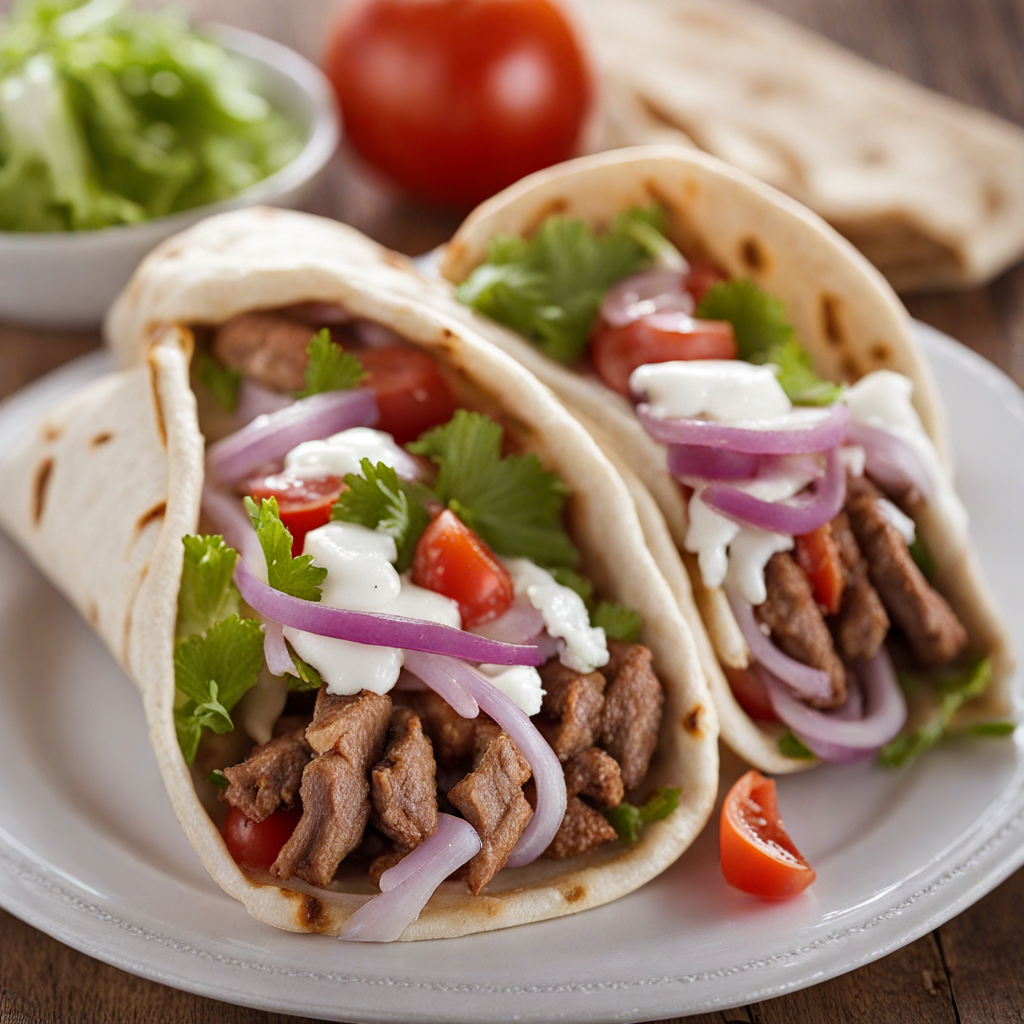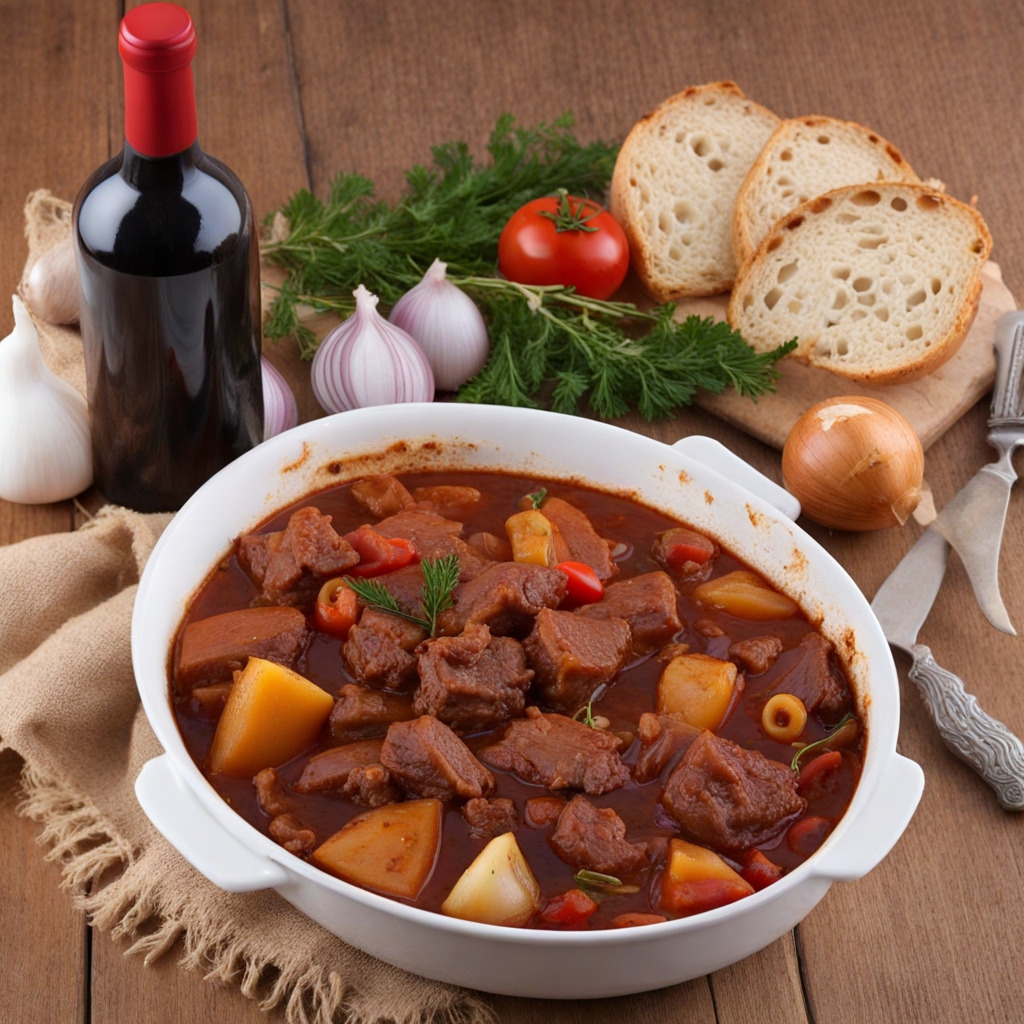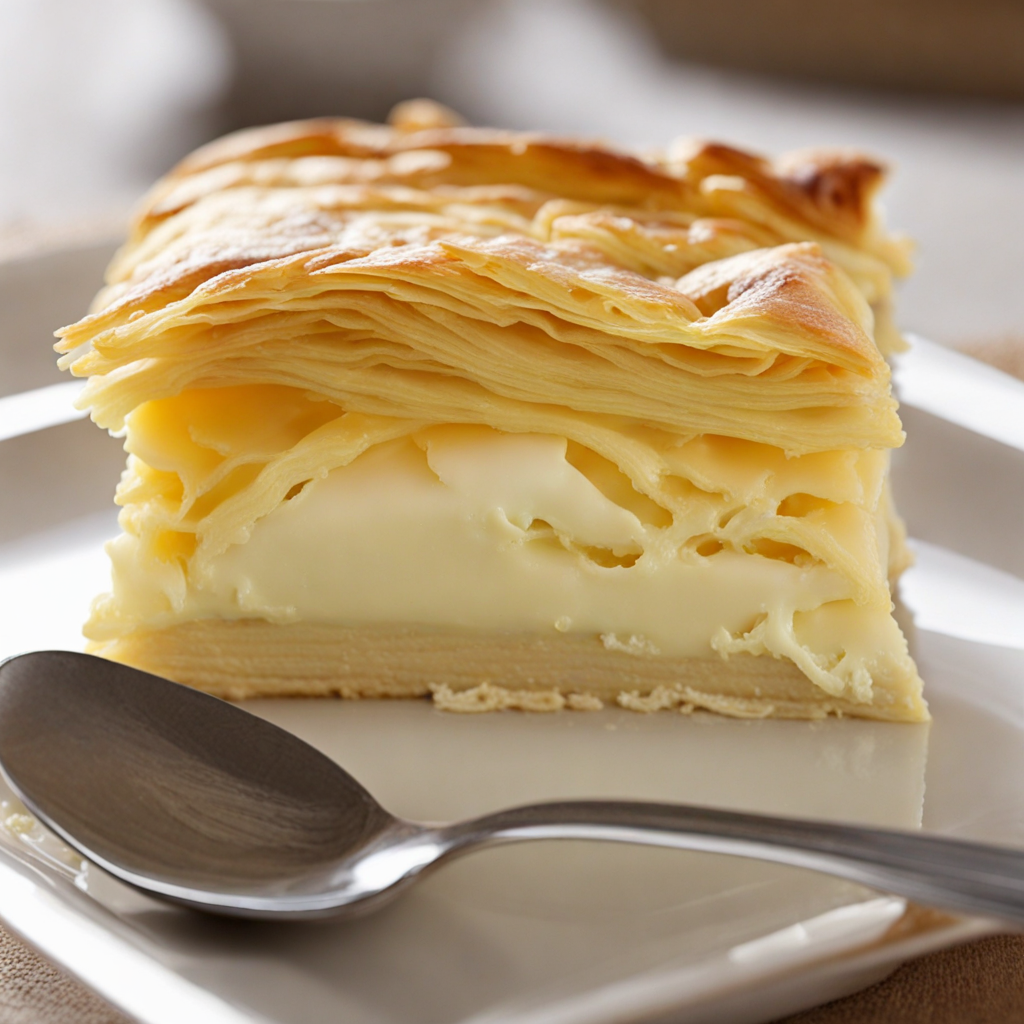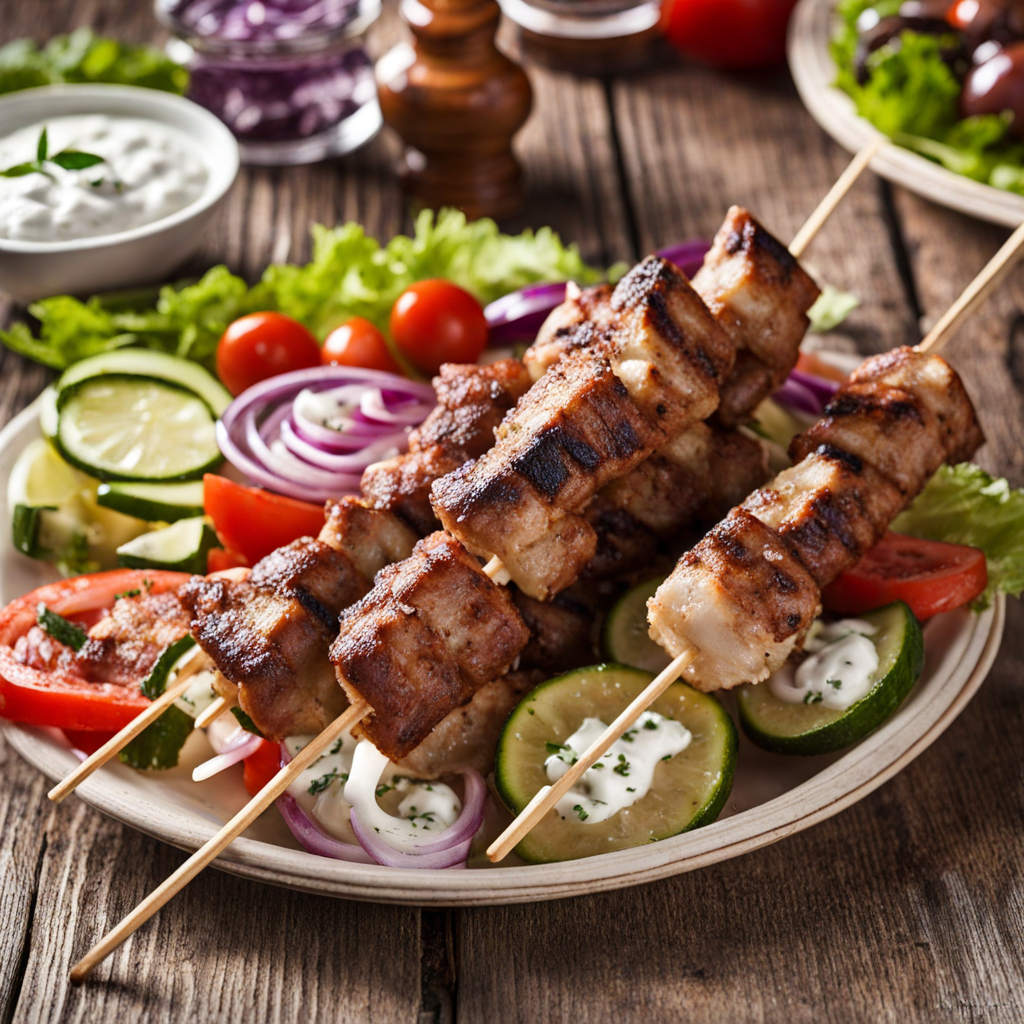Baklava
Baklava is a rich and indulgent dessert that hails from Greece, known for its captivating layers of flaky pastry and sweet, nutty filling. The base of this delightful treat is made from phyllo dough, a delicate pastry that is painstakingly rolled out into thin sheets. Each layer is brushed generously with melted butter, creating a crisp texture that contrasts beautifully with the luscious interior. The filling typically consists of a mix of finely chopped nuts, such as walnuts or pistachios, combined with fragrant spices like cinnamon, which infuses the pastry with warmth and depth of flavor. Once assembled, the baklava is cut into diamond or square shapes before being baked to golden perfection. The pièce de résistance comes after the baking process, where a luxurious syrup made from honey, sugar, and water is poured over the hot pastry. This syrup seeps into the layers, enhancing the sweetness and creating a sticky, luscious glaze that binds the baklava together. The combination of crunchy textures and syrupy sweetness offers a delightful contrast that is utterly irresistible. Baklava is often enjoyed as a celebratory dessert, served during festive occasions, family gatherings, or simply as a treat to indulge in after a meal. Each bite delivers a burst of flavors, with the nuttiness of the filling harmonizing with the sweetness of the syrup, while the phyllo layers provide a satisfying crunch. Pairing baklava with a cup of strong Greek coffee or tea elevates the experience, making it a perfect way to explore the rich culinary traditions of Greece.
How It Became This Dish
Baklava: A Sweet Journey Through Time and Culture Baklava, known as Μπακλαβάς in Greece, is a beloved pastry that has transcended borders and cultures, delighting palates with its rich flavors and flaky texture. This iconic dessert, made of layers of filo pastry filled with nuts and sweetened with honey or syrup, has a history that is as intricate as its preparation. The story of baklava is a tapestry woven from the threads of ancient civilizations, cultural exchanges, and culinary innovations. Origins The origins of baklava are shrouded in the mists of antiquity, with many claiming its beginnings in the ancient civilizations of Mesopotamia. Some historians trace its roots back to the Assyrians around 800 B.C., who layered bread with nuts and honey, creating an early prototype of what would eventually become baklava. However, the dessert as we know it today is often linked to the Ottoman Empire, which played a crucial role in its development and popularization. By the 15th century, the Ottoman Turks had refined the art of pastry-making, and it was in the imperial kitchens of Istanbul that baklava began to flourish. The Ottomans, who had a profound appreciation for sweets, introduced the use of thin layers of dough—what we now know as filo pastry. This innovation allowed for the creation of the delicate, flaky texture that defines baklava. The use of nuts, particularly walnuts and pistachios, combined with the sweetness of honey or syrup, created a sumptuous dessert that quickly gained favor among the sultans and their courts. Cultural Significance Baklava is not just a dessert; it holds significant cultural and social importance in various regions. In Greece, it is often associated with celebrations and special occasions, such as weddings, religious holidays, and family gatherings. Its preparation can be a communal activity, with family members coming together to create multiple trays of baklava to share with friends and neighbors. In Greece, baklava is traditionally made with a combination of walnuts, cinnamon, and cloves, reflecting the country's rich agricultural heritage. The nuts are often finely chopped and mixed with spices, then layered between sheets of filo pastry brushed with melted butter. After baking, the dessert is soaked in a syrup made of honey, sugar, and lemon juice, which adds a glossy finish and enhances the flavors. Beyond Greece, baklava has become a symbol of hospitality in many Middle Eastern and Mediterranean cultures. In Turkey, it is often served with Turkish coffee, and in Lebanon, it is a staple during festivals. Each culture has its unique twist on baklava, incorporating local ingredients and traditions, which showcases the adaptability and timeless appeal of this pastry. Development Over Time As baklava spread throughout the Ottoman Empire and beyond, its recipe and presentation evolved. In the 19th century, as the empire began to decline, baklava found its way into various regions, with each area adding its flair. In Turkey, for instance, the use of pistachios became more prevalent, while in the Balkans, almonds and hazelnuts were often used. The syrup also varied, with some regions favoring a rosewater-infused syrup, while others preferred a straightforward honey or sugar syrup. The migration of peoples and the rise of trade routes facilitated the exchange of culinary practices. Greek baklava, characterized by its use of walnuts and spices, began to influence neighboring cuisines. In Cyprus, a unique version called "kolokoti" is made with pumpkin filling, and in Egypt, baklava is often prepared with a thicker syrup and flavored with orange blossom water. In the 20th century, particularly after the global economic shifts and the rise of international tourism, baklava gained prominence outside its traditional confines. Bakeries and restaurants around the world began to feature baklava on their menus, introducing it to new audiences. It was embraced by the diaspora communities, who saw it as a way to connect with their heritage while also appealing to the diverse palates of their new homes. Baklava in Contemporary Times Today, baklava remains a cherished dessert, celebrated for its rich history and the craftsmanship involved in its preparation. The art of making baklava is often passed down through generations, with family recipes holding an invaluable place in culinary traditions. In Greece, baklava is typically enjoyed with a cup of coffee or tea, often served with a side of ice cream for an added layer of indulgence. Modern interpretations of baklava have emerged, with chefs experimenting with flavors and ingredients. Some have incorporated chocolate, while others have created savory versions, showcasing the versatility of this beloved pastry. Vegan and gluten-free adaptations have also gained popularity, ensuring that baklava can be enjoyed by a broader audience. The cultural significance of baklava continues to thrive, as it is often used to symbolize hospitality and generosity. During festive occasions, it is common to see baklava being gifted or shared, reinforcing bonds within communities. Additionally, it serves as a reminder of the shared history and interconnectedness of cultures across the Mediterranean and the Middle East. Conclusion Baklava is more than just a dessert; it is a testament to the rich tapestry of human history, culture, and culinary artistry. From its ancient origins to its modern interpretations, baklava has endured and adapted, remaining a beloved treat that brings people together. It stands as a symbol of tradition, family, and the sweetness of life, inviting all who partake in its layers to savor not just its flavors, but the stories that have shaped it over millennia. As we enjoy a piece of baklava, we partake in a shared legacy, a delightful convergence of cultures and histories, all wrapped up in flaky pastry.
You may like
Discover local flavors from Greece



